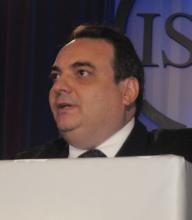MIAMI BEACH – Hypogastric artery endorevascularization using the sandwich technique was associated with fewer complications than was hypogastric artery exclusion by coil embolization for the treatment of abdominal aortic aneurysm with concomitant bilateral common iliac artery aneurysm in a series of 79 patients.
A total of 158 common iliac artery aneurysms were treated using either the same technique bilaterally or a different technique in each side. In the first group, 40 hypogastric artery endorevascularization procedures were performed using the sandwich technique, including 6 bilateral procedures. In the second group, 118 hypogastric artery exclusion procedures were performed using coil embolization followed by positioning of a limb extension to the external iliac artery, including 45 bilateral procedures, Dr. Armando C. Lobato reported at the International Symposium on Endovascular Therapy 2013.
At a mean of 37 months’ follow-up, permanent buttock claudication rates were significantly higher in group two (12.7% vs. 2.5%), as were late type II endoleak rates (15.5% vs. 2.5%), said Dr. Lobato of the Sao Paulo Vascular and Endovascular Surgery Institute, Beneficencia Portuguesa Hospital, Sao Paulo, Brazil.
The technical success rate was 100% in both groups, and related mortality and postoperative aneurysm rupture rates did not differ significantly between the groups. Early mortality was 0% and 1.4% in groups one and two, respectively; late mortality was 0% and 2.8% in the groups, respectively; and the postoperative aneurysm rupture rate was 0% and 1.4% in the groups, respectively, he said.
Rates of iliac limb migration, late type IB endoleak, type III endoleak, iliac limb occlusion, and reintervention also were similar in the two groups.
On multivariate regression analysis, bilateral hypogastric artery exclusion by coil embolization was significantly associated with permanent buttock claudication and late type II endoleak, he noted.
The findings provide further validation of the sandwich technique, which was developed by Dr. Lobato to overcome anatomical and device-related constraints encountered during endovascular aneurysm repair (EVAR). The technique has shown promise in prior studies and earlier reports from Dr. Lobato’s case series.
Dr. Lobato reported having no disclosures.


